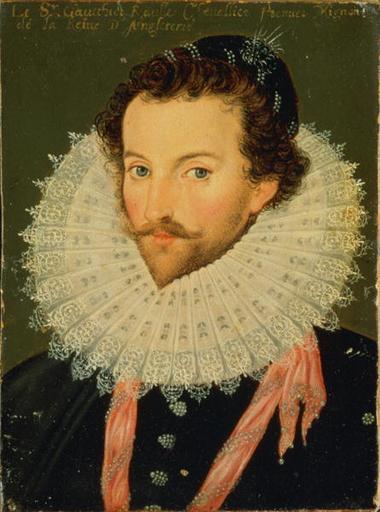MAKE A MEME
View Large Image

| View Original: | Sir_Walter_Raleigh,_French_School.jpg (445x600) | |||
| Download: | Original | Medium | Small | Thumb |
| Courtesy of: | commons.wikimedia.org | More Like This | ||
| Keywords: people Raleigh was born to a Protestant family in Devon, the son of Walter Raleigh and Catherine Champernowne. Little is known for certain of his early life, though he spent some time in Ireland, in Killua Castle, Clonmellon, County Westmeath, taking part in the suppression of rebellions and participating in two infamous massacres at Rathlin Island and Smerwick, later becoming a landlord of lands confiscated from the Irish. He rose rapidly in Queen Elizabeth I's favour, being knighted in 1585, and was involved in the early English colonisation of the New World in Virginia under a royal patent. In 1591 he secretly married Elizabeth Throckmorton, one of the Queen's ladies-in-waiting, without requesting the Queen's permission, for which he and his wife were sent to the Tower of London. After his release, they retired to his estate at Sherborne, Dorset. In 1594 Raleigh heard of a "City of Gold" in South America and sailed to find it, publishing an exaggerated account of his experiences in a book that contributed to the legend of El Dorado. After Queen Elizabeth died in 1603, Raleigh was again imprisoned in the Tower, this time for allegedly being involved in the Main Plot against King James I, who was not favourably disposed toward him. In 1616, however, he was released in order to conduct a second expedition in search of El Dorado. This was unsuccessful and the Spanish outpost at San Thomé was ransacked by men under his command. After his return to England he was arrested and, after a show trial held mainly to appease the Spanish after Raleigh's attack of San Thomé, he was beheaded at Whitehall. Raleigh was born to a Protestant family in Devon, the son of Walter Raleigh and Catherine Champernowne. Little is known for certain of his early life, though he spent some time in Ireland, in Killua Castle, Clonmellon, County Westmeath, taking part in the suppression of rebellions and participating in two infamous massacres at Rathlin Island and Smerwick, later becoming a landlord of lands confiscated from the Irish. He rose rapidly in Queen Elizabeth I's favour, being knighted in 1585, and was involved in the early English colonisation of the New World in Virginia under a royal patent. In 1591 he secretly married Elizabeth Throckmorton, one of the Queen's ladies-in-waiting, without requesting the Queen's permission, for which he and his wife were sent to the Tower of London. After his release, they retired to his estate at Sherborne, Dorset. In 1594 Raleigh heard of a "City of Gold" in South America and sailed to find it, publishing an exaggerated account of his experiences in a book that contributed to the legend of El Dorado. After Queen Elizabeth died in 1603, Raleigh was again imprisoned in the Tower, this time for allegedly being involved in the Main Plot against King James I, who was not favourably disposed toward him. In 1616, however, he was released in order to conduct a second expedition in search of El Dorado. This was unsuccessful and the Spanish outpost at San Thomé was ransacked by men under his command. After his return to England he was arrested and, after a show trial held mainly to appease the Spanish after Raleigh's attack of San Thomé, he was beheaded at Whitehall. Sir Walter Raleigh, French School.jpg Sir Walter Raleigh http //images bridgeman co uk/cgi-bin/bridgemanImage cgi/600 XAM 890270 7055475/68919 JPG bridgeman co uk century 16 French School Public domain art PD-old Sir Walter Raleigh Raleigh was born to a Protestant family in Devon, the son of Walter Raleigh and Catherine Champernowne. Little is known for certain of his early life, though he spent some time in Ireland, in Killua Castle, Clonmellon, County Westmeath, taking part in the suppression of rebellions and participating in two infamous massacres at Rathlin Island and Smerwick, later becoming a landlord of lands confiscated from the Irish. He rose rapidly in Queen Elizabeth I's favour, being knighted in 1585, and was involved in the early English colonisation of the New World in Virginia under a royal patent. In 1591 he secretly married Elizabeth Throckmorton, one of the Queen's ladies-in-waiting, without requesting the Queen's permission, for which he and his wife were sent to the Tower of London. After his release, they retired to his estate at Sherborne, Dorset. In 1594 Raleigh heard of a "City of Gold" in South America and sailed to find it, publishing an exaggerated account of his experiences in a book that contributed to the legend of El Dorado. After Queen Elizabeth died in 1603, Raleigh was again imprisoned in the Tower, this time for allegedly being involved in the Main Plot against King James I, who was not favourably disposed toward him. In 1616, however, he was released in order to conduct a second expedition in search of El Dorado. This was unsuccessful and the Spanish outpost at San Thomé was ransacked by men under his command. After his return to England he was arrested and, after a show trial held mainly to appease the Spanish after Raleigh's attack of San Thomé, he was beheaded at Whitehall. | ||||